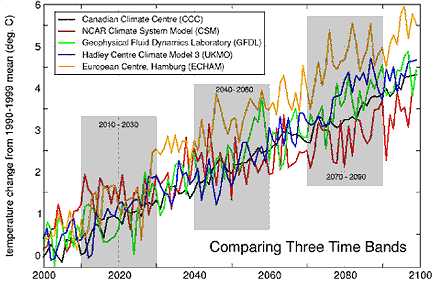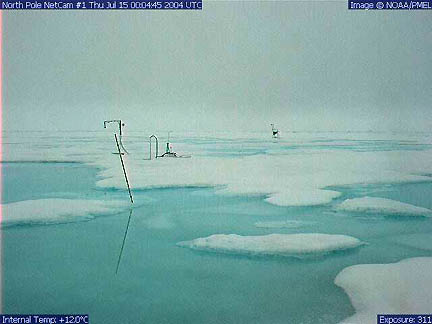
November 2, 2004 Fairbanks, Alaska – More than 250 scientists and six circumppolar organizations, which have participated in the Arctic Climate Impact Assessment, will meet November 9-12, 2004, in Reykjavik, Iceland, to discuss recent warnings in the International Arctic Research Center’s (IARC) new report prepared for the eight nations around the Arctic Circle: Canada, Denmark, Finland, Iceland, Norway, Russia, Sweden and the United States.
Submarines have been used to collect data about Arctic sea ice which has shrunk by 40% over a forty year period from 1960 to 1999. Global Climate Model Projects shown above indicate that for the foreseeable future, the temperature trend at the North Pole is ever-upward. Thus, the projection that beginning around the summer of 2060, all Arctic ocean ice will melt to a vast sea. What will polar bears and seals hunt from? What will happen to the 600 million birds that breed every year in the far north? Are those animals and others threatened with extinction now that global warming at the poles seems to be the future trend.
Human populations will also be affected. Buildings and roads will rise, sink and crack as the permafrost melts. Nicola Saltman, a program leader of climate change at the World Wildlife fund, says the new data means, “Life on Earth will change beyond recognition with the loss of the ice sheet at the North Pole” for the summer months. “This report shows that climate change is happening now and highlights the urgent need for immediate action, starting with the Arctic governments, who must reduce their CO2 emissions.”
As the ice melts entirely at the Arctic, the dark waters will not reflect back as much sunlight as the ice and snow has. So, as the ice disappears, the region will absorb more of the sun’s energy and heat up more causing more melt.

Website:
http://www.iarc.uaf.edu/acia.php
© 1998 - 2024 by Linda Moulton Howe.
All Rights Reserved.

